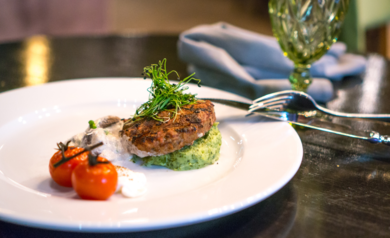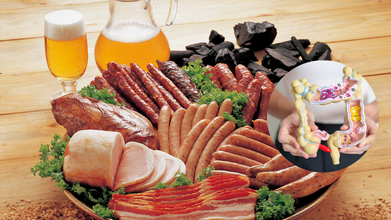- Health Conditions A-Z
- Health & Wellness
- Nutrition
- Fitness
- Health News
- Ayurveda
- Videos
- Medicine A-Z
- Parenting
Ozempic Is Shrinking Appetites And Restaurant Portions Too, Is It Helping Or Harming?

Credits: Freepik
Restaurants are quietly rewriting their menus—and it’s not just to keep up with seasonal flavors or dietary fads. The real driver? A class of injectable weight-loss drugs called GLP-1 receptor agonists, most notably Ozempic, Wegovy, Mounjaro, and Zepbound.
Originally developed to manage Type 2 diabetes, these medications have now skyrocketed in popularity for one big reason: they help people lose weight by drastically reducing appetite. And this isn’t a trend limited to influencers on TikTok or celebrity endorsements. According to a May 2025 report by FAIR Health, about 2% of American adults—roughly 6 million people—are currently using GLP-1 drugs for weight management. That’s not a niche group. That’s a market with teeth, and the food industry is taking note.
Why Restaurants Are Shrinking Their Plates?
Across the US, eateries are rolling out what’s being dubbed the “Ozempic menu”—smaller, more protein-rich portions that cater to those on GLP-1s who can’t eat the way they used to. These are not your typical “light bites” or calorie-counted diet meals from the 2000s. Instead, they’re designed for people who now feel full after just four bites, as one TikTok user described: “I took four little bites, and I can’t eat any more of my food 'cause I’m full.”
The biology backs it up. GLP-1 drugs mimic the action of gut hormones that signal satiety to the brain. The result? Smaller appetites, reduced cravings, and a tendency to avoid heavy, greasy, or ultra-processed foods but it’s not just about how much people are eating—it’s also about what they’re eating.
For decades, restaurants and packaged food brands pushed the “bigger is better” model. Think supersized fries, 20-ounce sodas, and all-you-can-eat buffets. But that equation is starting to collapse under the influence of GLP-1s.
New research from the University of Arkansas Agricultural Experiment Station shows that people on these drugs consume about 700 fewer calories per day and steer clear of processed snacks, red meat, refined grains, and sugary drinks. Instead, their diets trend toward fruit, leafy greens, water, and high-protein foods.
It’s a massive shift—and restaurants are adapting fast. Instead of pushing larger portions to increase perceived value, some are offering nutrient-dense meals in smaller servings, optimized for digestion and satiety. Think protein-packed bowls, cauliflower-crust pizzas, or sandwich melts with whole grains—all designed to be GLP-1-friendly.
Major food companies aren’t sitting this out. Nestlé launched a frozen food line in 2024 specifically tailored to consumers on GLP-1s. The meals aren’t just low-cal—they’re balanced to maintain muscle mass, avoid nutrient deficiencies, and support healthy metabolism, which are growing concerns for long-term users of these medications.
Unlike the old “diet food” playbook—low fat, low everything—today’s approach focuses on preventing muscle loss, fortifying foods with fiber and vitamins, and adjusting textures for easier digestion.
Expect to see more brands follow suit, with single-serving sizes, high-protein snacks, and products that offer real functional value—not just calorie control.
Also Read: Ozempic Vulva To Ozempic Smell – Unexpected Ways Of Weight Loss Jabs Change Your Body
The shift toward GLP-1-friendly dining is more than a marketing gimmick. It reflects a deep change in how Americans are interacting with food. Diners who used to order a full entrée might now split a main course or order just an appetizer. Chefs are learning to rethink portion sizes without compromising taste or presentation.
In upscale restaurants, this may look like smaller tasting menus. In fast-casual spots, it may mean mini versions of signature bowls or build-your-own plates that offer controlled portions with customizable nutrients.
And it's not only about smaller sizes—menus are also evolving to exclude trigger foods that can worsen GLP-1 side effects, like fried items or ultra-rich desserts. Patrons on these drugs are more sensitive to nausea and stomach discomfort, so restaurants are adjusting recipes accordingly.
Why Is Grocery Spending Already Shrinking?
A Cornell University study recently found that households with at least one GLP-1 user spent 6% less on groceries overall. That’s a red flag for the food industry but also an opportunity to pivot toward value through quality, not quantity.
Instead of upselling bigger boxes of snacks or mega-size frozen dinners, grocers and food brands will need to rethink how to stay relevant to a customer who eats less but wants more nutrition per bite.
Are Weight Loss Drugs Changing How We Eat?
We’re living through a transformation in the food landscape, where demand isn’t driven by cravings but by pharmacology. For years, weight-loss diets were built around willpower. Now, with drugs like Ozempic, the body’s natural hunger cues are being reprogrammed—and the entire food ecosystem is scrambling to catch up.
Restaurants creating Ozempic menus are just the beginning. As the number of GLP-1 users continues to grow—possibly reaching tens of millions in the coming years—the very definition of what and how we eat is being rewritten.
Also Read: Mounjaro Price Hike: Here's All That You Need To Know About This Weightloss Drug
Whether you’re in a high-end bistro or grabbing takeout, expect to see menus shrink, protein rise, and food marketing get a functional, health-forward upgrade.
The rise of GLP-1 drugs is reshaping the food industry—from menus and grocery shelves to portion sizes and nutrient density. Ozempic menus aren’t a fad—they’re a reflection of how medicine is changing mealtime.
India Sees a 4000% Increase In Sale Of Ultra Processed Food, Finds Lancet Study

Credits: Canva
The latest Lancet Study warns that India is experiencing a rapid and worrying rise in the consumption of ultra-processed foods (UPFs). The UPF includes food like instant noodles, packaged snacks, ready-to-eat meals, sugary beverages, mass-produced breads, processed meats, and other industrially formulated products.
The paper was authored by 43 global experts who noted that traditional Indian meals are increasingly being replaced by convenient but nutritionally poor foods, which are not contributing to a rise in chronic diseases.
The Series calls for “immediate and decisive public health action”, stressing that individual willpower alone cannot fix dietary patterns. Instead, the availability, affordability, marketing, and widespread promotion of UPFs must be addressed at the policy level.
The Rate Of UPFs Growth In India
The shift has been dramatic. The retail sales of UPFs in India jumped from ₹7,996 crore in 2006 to ₹3.3 lakh crore in 2019. In other words, the initial value for the same products in 2006 was less than $ 0.9 Billion and by 2019, it reached the value of $ 38 Billion, leading to a forty-fold rise, or an increase around 4000%. This reflects a massive surge of how deeply these products have entered the Indian household.
During the same period, obesity rates among both men and women have doubled. Today, nearly one in four Indians is obese, one in ten has diabetes, and one in three has abdominal obesity. Childhood obesity has also risen, increasing from 2.1% to 3.4% between 2016 and 2019–21. The authors warn that this pattern mirrors global trends where UPF consumption is strongly linked to weight gain and metabolic disorders.
According to the papers, the UPF industry is a central driver of this shift. Because UPFs are more profitable than minimally processed foods, corporations invest heavily in their production, distribution, and marketing. This profit-focused model encourages continuous expansion, making these foods widely accessible and aggressively promoted.
why Is This Happening In India?
The Lancet Series highlighted that the major concerns are due to corporate influence and gap in India's food regulation. The marketing network of corporate influence often delay or weaken public health policies.
They uses strategies like direct lobbying and political pressure, involvement in the government committees, litigation to block regulations, funding research that creates doubt or shifts the blames and influence public opinion through advertising and public relation campaigns.
“UPFs are advertised addictions. A ban on their advertising and sponsorship is needed,” said Prof. Srinath Reddy, Chancellor of PHFI University of Public Health Sciences to The Tribune.
What Are The Health Impacts?
The authors emphasize that the harm caused by UPFs extends far beyond poor nutrition. Industrial processes, such as chemical modification, extrusion, and the addition of synthetic ingredients, can alter food structure in ways that negatively affect metabolism, immunity, and long-term health.
Regular consumption of UPFs has been linked to higher risks of obesity, Type-2 diabetes, cardiovascular disease, depression, and premature death. “These foods contribute to diminished immunity, aggravated inflammation, and a rise in life-threatening chronic diseases,” Dr. Reddy said.
After Lancet Links Ultra-Processed Foods to Organ Damage, New Study Ties Them to Bowel Polyps in Women Under 50

Credits: Canva
Health and Me previously reported on the latest Lancet Study, which is world's largest review, as per the Lancet that links consumption of ultra-processed food (UPF) with harm in every major organ system in the human body. A new study published in Jama Oncology by Andre T Chan, also cited on The Lancet Oncology now links the consumption of UPF with bowel polyps in women younger than 50 years. The study notes that these women are at a 45% increased risk of developing bowel polyps, which can further develop into colorectal cancer.
What Are Ultra Processed Foods?
UPFs are modern, highly engineered products that are made from cheap industrial ingredients like hydrogenated oils, protein isolates, and glucose or fructose syrups. They are also combined with cosmetic additives like dyes, artificial sweeteners, and emulsifiers. These foods are intentionally formulated to be hyper-palatable, and profitable. This is why UPFs are easily able to replace fresh or minimally processed food and traditionally home cooked meals around the world.
Also Read: China’s ‘Zombie Cell’ Pill Claims To Extend Human Life To 150—Could It Work?
What Did The Study Find?
The new findings come from the Nurses' Health Study II, which is a long-running US Cohort involving female registered nurses.
This analysis followed participants from 1991 to 2015, examining whether UPF consumption was linked to early-onset colorectal cancer (EOCRC) precursors. Every four years, participants completed detailed food-frequency questionnaires, which researchers used to calculate UPF intake based on the Nova classification system, a widely used framework that categorizes foods by degree and purpose of processing.
According to the questionnaires, the biggest contributors to UPF intake were ultra-processed breads and breakfast items (23%), sauces and condiments (22%), and sugar-sweetened or artificially sweetened beverages (20%).
Researchers assessed two types of EOCRC precursors: conventional adenomas (polyps) and serrated lesions, both of which were verified through medical and pathology records.
Over 24 years, among 29,105 women with an average age of 45, the study recorded 1,189 adenomas and 1,598 serrated lesions. The data revealed that women in the highest UPF consumption group, where UPFs made up 42% of daily calories, had a 45% higher risk of developing conventional adenomas compared to those in the lowest intake group (23% of daily calories). The median UPF intake across the cohort was 35% of total calories.
How Can UPFs Increase Polyp Risk?
Chan, speaking to The Lancet Oncology explained that UPFs may impair the gut’s protective barrier or disrupt the intestinal lining, triggering inflammation and reducing the gut’s ability to repair itself, conditions that may encourage tumor development.
The authors offer a possible explanation for why only adenomas, not serrated lesions, were associated with UPFs. They suggest that mechanisms linked to UPFs, such as microbiome disruption, inflammatory signalling, and diet-related genotoxins, may accelerate polyp formation, especially in younger individuals.
What makes these study even more relevant is that the study arrives after The Lancet has released a major three-paper series on UPFs and health, with many calling the need for action to be similar to the historic action against the tobacco industry.
5 Ultra-Processed Foods You Should Definitely Skip, As New Lancet Study Links Them To Organ Damage

Credits: Canva
The rise of ultra-processed foods (UPFs) in daily diets is harming public health and driving chronic illnesses that range from obesity and diabetes to cancer across the world. It is also widening health gaps, according to a new Lancet series published on Wednesday, November 19, 2025.
The study by Lancet noted that the problem demands a coordinated global effort that challenges corporate influence and reshapes food systems so that people can access healthier and more sustainable meals.
Dr Arun Gupta, a pediatrician and one of the contributors to the three-part Lancet Series, said that India is experiencing the same pattern highlighted in the report. He explained that familiar home cooked plates are steadily being replaced by intensely appealing industrial UPF products, pushed through heavy marketing and constant advertising, as per The Independent.
With this new research drawing significant interest, here is a look at the ultra processed foods that should be kept off your plate.
What Are Ultra Processed Food (UPF)?
UPFs are items that have undergone multiple industrial steps and include artificial additives, salt and sugar. Common examples are breakfast cereals, ready meals, fizzy drinks and packaged snacks like crisps or sweets.
Steve Bennett, a qualified health coach who has advised the House of Lords’ committee on food, diet and obesity, told The Independent that UPFs are factory-produced products filled with additives that no one would normally use at home. These include emulsifiers, stabilisers and artificial flavours. He said the priority behind them is long shelf life and profit rather than nourishment.
Ultra-Processed Food You Should Avoid
As the new study by Lancet outlines the connection between ultra-processed food, organ damage and chronic disease, these are the items to watch out for.
Breakfast Cereals
Many breakfast cereals contain two to four teaspoons of sugar in a standard 40 g serving, with some of the least healthy versions reaching nearly four teaspoons even before milk or fruit are added. Yet Bennett said the bigger concern lies with cereals marketed as healthy, where much of the fibre is removed. He explained that even wholegrain varieties can turn into concentrated sugar because processing strips away protective fibre.
Ready To Eat Meals
Ready to eat meals, often sold frozen or chilled, are partly or fully cooked and only need reheating before serving. Bennett described these meals as chemical mixtures and advised shoppers to look for hidden sugars among the first few ingredients, especially anything ending in ose such as glucose or fructose or any form of syrup. He also pointed to emulsifiers like polysorbates and any ingredient that begins with E followed by numbers as signs to be cautious.
Low Fat Products
Bennett said people should be alert to misleading terms on packaging, including natural, low fat or 'source of fibre', and stay away from products with very long ingredient lists. Many UPFs are sold as healthy choices, which adds to the confusion.
One in twenty Britons even believe fresh fruits and vegetables qualify as UPFs, showing how unclear the category has become. He added that protein bars are often sweets with protein powder mixed in and low fat yoghurts usually contain a high amount of sugar after the fat is removed.
While most people recognise ready meals as ultra processed, fewer understand that low fat yoghurts fall into the same group. Less than half know that protein bars or supermarket salads can also be classified as UPFs, though nutritionists include them.
Supermarket Bread
Modern packaged bread is heavily processed and often stripped of the fibre that once made it nourishing. One of the main problems is the consistent removal of fibre during manufacturing. He said fibre works like a natural brake, slowing the body’s sugar absorption and protecting the gut. Without it, sugar enters the bloodstream very quickly.
Energy Drinks
These legal stimulants mix sugars such as glucose and sucrose with caffeine and other ingredients to raise alertness. Although energy drinks are promoted as a way to sharpen focus, frequent use can make the heart work harder and may lead to health problems, especially among children and teenagers.
To steer clear of the UPF trap, try preparing more homemade meals and read labels with care. If you notice an ingredient that does not sound familiar, try reducing your reliance on that product. When you do choose UPFs, pick those that still offer some nutritional value, such as wholegrain bread or baked beans. By cutting down the number of UPFs in your routine, even by replacing one or two of your usual items like bread or cereal, you may lower the health risks linked to them.
© 2024 Bennett, Coleman & Company Limited

